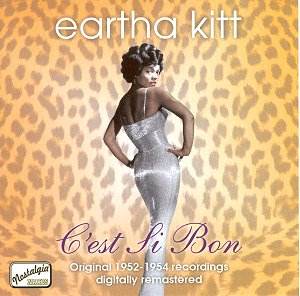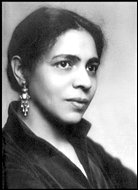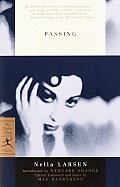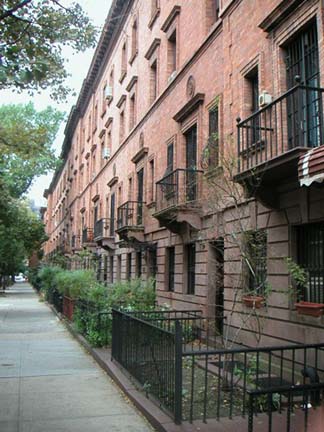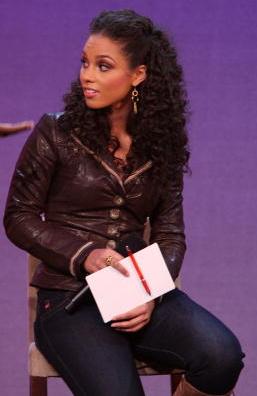 Alicia Cook (c. 1979- ), better known by her stage name of Alicia Keys, was one of the top American R&B singers of the 2000s. She is best known for “Fallin'” (2001) , which made her name and is still her most unforgettable song to date. Smokey Robinson says she is one of the best new singers.
Alicia Cook (c. 1979- ), better known by her stage name of Alicia Keys, was one of the top American R&B singers of the 2000s. She is best known for “Fallin'” (2001) , which made her name and is still her most unforgettable song to date. Smokey Robinson says she is one of the best new singers.
So far six of her songs have hit number one on the American R&B chart:
- 2001: Fallin’
- 2003; You Don’t Know My Name
- 2004: If I Ain’t Got You
- 2004: My Boo (with Usher)
- 2007: No One
- 2008: Like You’ll Never See Me Again
“Superwoman” and “Teenage Love Affair” never hit number one.
Half these songs also hit number one on the American pop chart: “Fallin'”, “My Boo” and “No One”.
For comparison, during this same period Beyonce had five number one hits on both the R&B and pop charts in America and Mariah Carey had three each.
Mariah and Beyonce have sold way more records than Alicia Keys: they have been at it longer and their music crosses over to white audiences better.
Alicia Keys is not only talented and successful but beautiful – one of the most beautiful black women according to white people. She is half Italian by blood and looks nearly white.
Her father is black (Jamaican); her mother is white (Italian-American). She considers herself to be black, not biracial or mixed race. Unlike with Mariah Carey, it has never been a question. Also, unlike Carey, her early music was more clearly black too.
 She was born in Harlem. Her parents split when she was two. She saw little of her father, a flight attendant, though he did remain in her life. Her mother was often poor but somehow she always found money for Alicia’s piano lessons. Alicia:
She was born in Harlem. Her parents split when she was two. She saw little of her father, a flight attendant, though he did remain in her life. Her mother was often poor but somehow she always found money for Alicia’s piano lessons. Alicia:
I’ve had a deep love for music since I was four… . Music came before everything, everything, everything. I would risk everything for it.
By seven she could play classical piano. By 11 she was writing songs. One of the songs on her first album she wrote at 14. She continued to learn and practise her singing and piano.
In 1997 she got a record deal with Columbia Records – and dropped out of Columbia University. But then Columbia Records did what they did to Aretha Franklin and Bruce Springsteen before her: tried to make her into someone else:
I felt that they wanted me to be a clone of Mariah or Whitney, and I couldn’t do that. I’m not the sequined dress type, or the high-heeled type, or the all-cleavage type. I’m not coming like that for no one.
They parted ways.
Clive Davis, the very man who brought us Whitney Houston, stepped in. He was struck by her talent and beauty. She was struck by how he took her seriously.
After many delays – Davis was kicked out of Arista and formed J Records, bringing Keys with him – she completed her first album in 2001. “Nothing before its time,” she says. Davis got her on Oprah’s television show and the rest is history.
– Abagond, 2009.
See also:
- The Secret Life of Bees – she played one of the main characters
- The most beautiful black women according to white people
- Songs I have posted:
- 2001: Fallin’ – live
- 2003: You Don’t Know My Name
- 2008: Another Way to Die – a rock song with Jack White.
- 2008: Teenage Love Affair
- 2009: Try Sleeping with a Broken Heart
- Beyonce
- The blackness of Mariah Carey
- beyond black – Mariah is beyond black, Alicia Keys is not
- biracial
- black father, white mother
- Oprah Winfrey
- Harlem
- songs: the 2000s
 June Jordan (1936-2002) was an American writer, poet and professor. And one of my favourite authors. By the 1990s she had become one of the top black women writers in the country. She was best known as a poet, though she wrote children’s books and essays too.
June Jordan (1936-2002) was an American writer, poet and professor. And one of my favourite authors. By the 1990s she had become one of the top black women writers in the country. She was best known as a poet, though she wrote children’s books and essays too.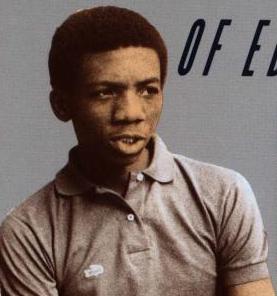 Edmund Perry (c. 1968-1985), a 17-year-old black boy, was shot dead on June 12th 1985 by Lee Van Houten, a white plainclothes policeman, a few blocks from where Perry lived on West 114th Street in Harlem. The New York Times does not ordinarily report murder north of 96th Street, but this time they did: Perry, it turned out, had just graduated from Exeter, one of the top private schools in America, and was set to go to Stanford University.
Edmund Perry (c. 1968-1985), a 17-year-old black boy, was shot dead on June 12th 1985 by Lee Van Houten, a white plainclothes policeman, a few blocks from where Perry lived on West 114th Street in Harlem. The New York Times does not ordinarily report murder north of 96th Street, but this time they did: Perry, it turned out, had just graduated from Exeter, one of the top private schools in America, and was set to go to Stanford University. Kelis Rogers (1979- ), better known as just Kelis, is an American R&B singer. She is best known for “Milkshake” (2003): “My milkshake brings all the boys to the yard, and they’re like, it’s better than yours. Damn right, it’s better than yours. I can teach you, but I have to charge.”
Kelis Rogers (1979- ), better known as just Kelis, is an American R&B singer. She is best known for “Milkshake” (2003): “My milkshake brings all the boys to the yard, and they’re like, it’s better than yours. Damn right, it’s better than yours. I can teach you, but I have to charge.”













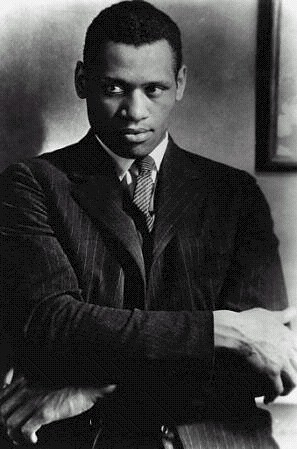 Paul Robeson (1898-1976) was an American singer, actor and a fighter for equal rights for all men. He is best remembered for singing “Ol’ Man River” (1936).
Paul Robeson (1898-1976) was an American singer, actor and a fighter for equal rights for all men. He is best remembered for singing “Ol’ Man River” (1936). Malcolm X (1925-1965) was one of two main black leaders in America in the 1960s, the other being Martin Luther King, Jr. They were both ministers, King a Christian, X a Muslim, and they both wanted equal rights for blacks, but they disagreed about how it could be achieved: King said it could be done through peaceful protest, Malcolm X said, “Give me a .45 calibre, then I’ll sing ‘We Shall Overcome'”.
Malcolm X (1925-1965) was one of two main black leaders in America in the 1960s, the other being Martin Luther King, Jr. They were both ministers, King a Christian, X a Muslim, and they both wanted equal rights for blacks, but they disagreed about how it could be achieved: King said it could be done through peaceful protest, Malcolm X said, “Give me a .45 calibre, then I’ll sing ‘We Shall Overcome'”.